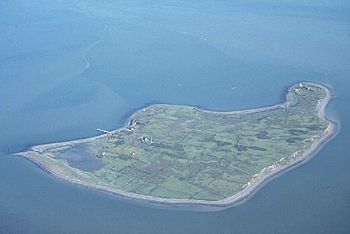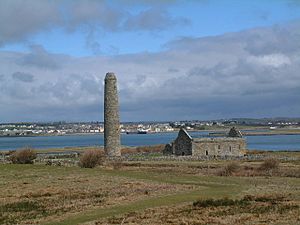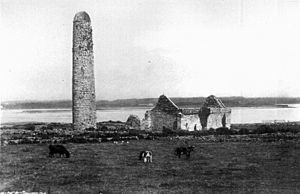Inis Cathaigh facts for kids
|
Native name:
Inis Cathaigh
|
|
|---|---|
 |
|
| Geography | |
| Location | Shannon Estuary |
| Coordinates | 52°36.45′N 9°31.9′W / 52.60750°N 9.5317°W |
| Area | 0.7 km2 (0.27 sq mi) |
| Administration | |
| Province | Munster |
| County | Clare |
| Demographics | |
| Population | none (permanent) |
| Pop. density | 0 /km2 (0 /sq mi) |
| Reference #: | 10 |
Inis Cathaigh or Scattery Island is a small island in the Shannon Estuary in Ireland. It is located off the coast of Kilrush in County Clare. The island's Irish name, Inis Cathaigh, used to be called Iniscathy in English. Later, it became Iniscattery and then Scattery.
Today, Scattery Island is home to a lighthouse and the remains of an old monastery. You can also see an Irish round tower and parts of an old artillery battery. No one lives on the island permanently anymore. The last people left in 1969.
Most of the island is now looked after by the Office of Public Works. They run a small visitor centre and work to keep the old buildings safe.
Contents
The Story of Saint Senan
Saint Senan was a very important person in Irish history. He was born around the year 488 in County Clare. His parents were Erean and Comgella. Even St. Patrick is said to have predicted his birth!
Senan studied under different abbots, learning about faith. He started his work by building a church near Enniscorthy around 510. This area is still known as Templeshannon, meaning "Senan's Church."
He traveled a lot, visiting places like Cornwall in England and Brittany in France. Some people believe he even went to Rome. Senan returned to Ireland around the year 520.
After building more churches in different parts of Ireland, he finally settled on Inis Cathaigh. Other holy people, like Saints Ciarán and Brendan, came to visit him. They had heard about his good deeds and miracles.
Inis Cathaigh became a very famous abbey and also the seat of a bishopric. This means it was the main church area for a bishop, and Saint Senan was its first bishop. This happened between 535 and 540.
There's a famous story about Saint Senan and a lady. It says that no woman was allowed to enter Inis Cathaigh. Not even Saint Senan's own sister, Saint Cannera, was allowed to land on the island. However, Senan did set up two convents for nuns elsewhere.
Legend says that when Saint Cannera died, she wanted to be buried near Senan. To follow his own rule, Senan waited until the tide was out. He buried her in the area between the high and low tide marks. This way, she was close to him but not officially on the "island." Saint Senan was buried in the abbey church on Inis Cathaigh on March 8th.
One of the earliest mentions of the island's Round Tower is found in the old Irish stories about Saint Senan.
Viking Raids and Settlements
The Vikings were fierce warriors and sailors from Scandinavia. They first attacked Inis Cathaigh in 815. Many monks living there were killed during these raids. The monastery was attacked many times over the years.
Eventually, in the mid-tenth century, the Vikings decided to settle on the island themselves. This led to battles with Irish kings who wanted to control the island.
Inis Cathaigh was an important part of the Viking Kingdom of Limerick. This kingdom controlled not just Limerick city but also other Viking bases in western Ireland. Because of its location at the mouth of the Shannon Estuary, the island controlled all ship traffic going up the river to Limerick.
Old records show that Viking kings of Limerick lived on Scattery Island in the 970s. In 977, Brian Boru, a powerful Irish king, defeated the Vikings. He killed Ivar of Limerick, the last Norse king of the city, and two of his sons on Inis Cathaigh.
Church History of Scattery Island
The Scattery Island Cathedral and monastery is a very old Christian site. Saint Senan founded a monastery here in the Shannon estuary. It is about 5 kilometers southwest of Kilrush, County Clare.
Today, you can still see the remains of Saint Senan's prayer house and his living quarters. There are also parts of seven small churches or chapels. The famous round tower and a holy well are also still there. The island was once fortified and has a lighthouse.
Long ago, the abbot-bishop of the monastery on Scattery Island was thought to have power over other church areas. These later became the dioceses of Killaloe, Limerick, and Ardfert.
In 1111, a special church area called a diocese was officially created for Inis Cathaig. However, this diocese was later joined with the Diocese of Killaloe in 1189. It was brought back for a short time by Pope Innocent VI in the 1300s. After that, the island became part of the Diocese of Killaloe again.
Today, Inis Cathaig is listed as a titular see by the Catholic Church. This means it's a former diocese that no longer has a resident bishop, but its name is used for bishops who don't have their own diocese to lead.
The Artillery Battery
On the south side of Scattery Island, there is an old artillery battery. This fort was built during the Napoleonic Wars. These wars involved France and many other European countries. The French had thought about invading Ireland, and the Shannon Estuary was one possible landing spot.
To protect against an invasion, several forts were built along the estuary. Scattery Island was chosen as one of these important defense points. A French general named Charles-François du Périer Dumouriez suggested building the battery here.
The battery is shaped like a half-circle, or a "D," with a dry moat around it. It had six large 24-pounder cannons. These cannons were mounted on special platforms that allowed them to turn 90 degrees. This gave the battery a wide firing range of over 200 degrees. The cannons could fire across the estuary. They could also work with another battery on Carrig Island to create a strong crossfire.
The barracks building on the battery's roof had two smaller howitzer cannons. These were for close-up defense if enemies tried to attack from behind. Even though these cannons alone couldn't stop a huge invasion, they could have caused a lot of damage to an enemy fleet.
Island Life and Demographics
In 1842, after a ship called the Windsor Castle was salvaged, Scattery Island became home to Shannon Estuary Pilots and their families. These pilots were skilled sailors who guided ships safely through the estuary. Families like the Brennan, Melican, and Scanlan lived on the island.
During the Great Famine in Ireland (1845-1850), many people died or left the country. However, the people on Scattery Island seemed to avoid the worst of it. The island's population actually grew from 65 people in 1841 to 99 in 1851. By 1861, there were 139 residents. The number of houses also increased.
It is believed that fishing, more shipping due to famine exports, and the pilots' work helped the islanders. These jobs provided good income for the families living there.
The last permanent residents left Scattery Island in 1969.
Images for kids
See also
 In Spanish: Inis Cathaigh para niños
In Spanish: Inis Cathaigh para niños

















